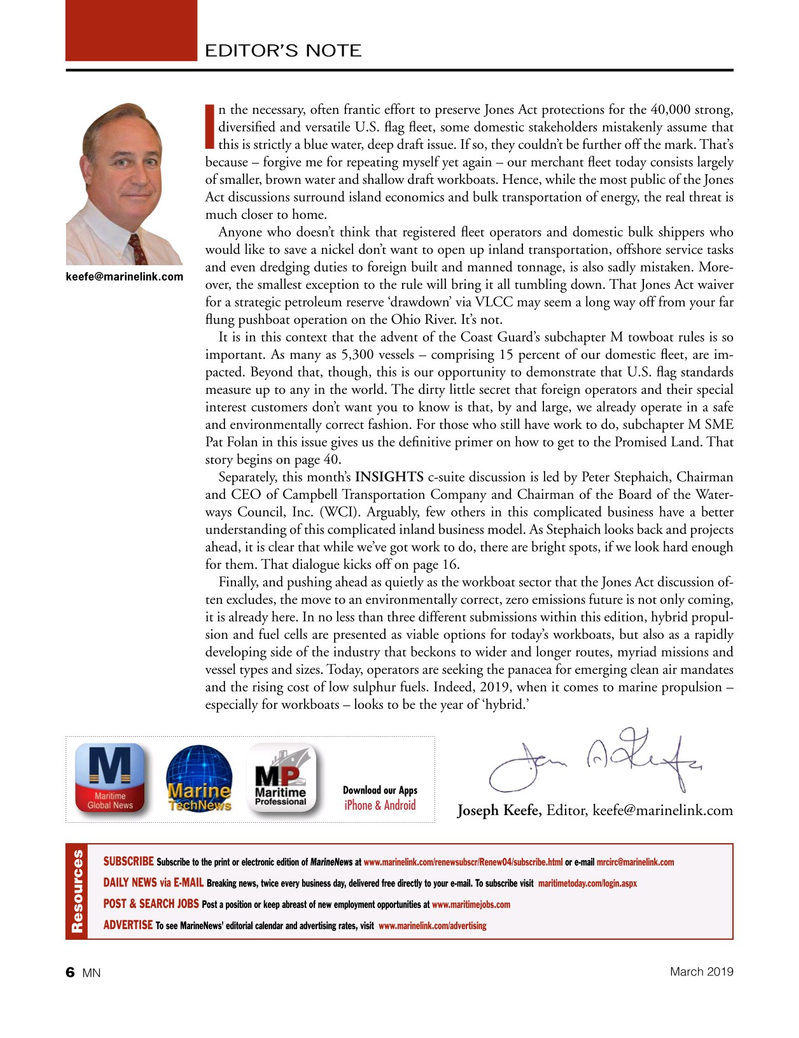
Page 6: of Marine News Magazine (March 2019)
Pushboats, Tugs & Assist Vessels
Read this page in Pdf, Flash or Html5 edition of March 2019 Marine News Magazine
EDITOR’S NOTE n the necessary, often frantic effort to preserve Jones Act protections for the 40,000 strong, diversifed and versatile U.S. fag feet, some domestic stakeholders mistakenly assume that
I this is strictly a blue water, deep draft issue. If so, they couldn’t be further off the mark. That’s because – forgive me for repeating myself yet again – our merchant feet today consists largely of smaller, brown water and shallow draft workboats. Hence, while the most public of the Jones
Act discussions surround island economics and bulk transportation of energy, the real threat is much closer to home.
Anyone who doesn’t think that registered feet operators and domestic bulk shippers who would like to save a nickel don’t want to open up inland transportation, offshore service tasks and even dredging duties to foreign built and manned tonnage, is also sadly mistaken. More- [email protected] over, the smallest exception to the rule will bring it all tumbling down. That Jones Act waiver for a strategic petroleum reserve ‘drawdown’ via VLCC may seem a long way off from your far fung pushboat operation on the Ohio River. It’s not.
It is in this context that the advent of the Coast Guard’s subchapter M towboat rules is so important. As many as 5,300 vessels – comprising 15 percent of our domestic feet, are im- pacted. Beyond that, though, this is our opportunity to demonstrate that U.S. fag standards measure up to any in the world. The dirty little secret that foreign operators and their special interest customers don’t want you to know is that, by and large, we already operate in a safe and environmentally correct fashion. For those who still have work to do, subchapter M SME
Pat Folan in this issue gives us the defnitive primer on how to get to the Promised Land. That story begins on page 40.
Separately, this month’s INSIGHTS c-suite discussion is led by Peter Stephaich, Chairman and CEO of Campbell Transportation Company and Chairman of the Board of the Water- ways Council, Inc. (WCI). Arguably, few others in this complicated business have a better understanding of this complicated inland business model. As Stephaich looks back and projects ahead, it is clear that while we’ve got work to do, there are bright spots, if we look hard enough for them. That dialogue kicks off on page 16.
Finally, and pushing ahead as quietly as the workboat sector that the Jones Act discussion of- ten excludes, the move to an environmentally correct, zero emissions future is not only coming, it is already here. In no less than three different submissions within this edition, hybrid propul- sion and fuel cells are presented as viable options for today’s workboats, but also as a rapidly developing side of the industry that beckons to wider and longer routes, myriad missions and vessel types and sizes. Today, operators are seeking the panacea for emerging clean air mandates and the rising cost of low sulphur fuels. Indeed, 2019, when it comes to marine propulsion – especially for workboats – looks to be the year of ‘hybrid.’
Download our Apps iPhone & Android
Joseph Keefe, Editor, [email protected]
SUBSCRIBE Subscribe to the print or electronic edition of at www.marinelink.com/renewsubscr/Renew04/subscribe.html or e-mail [email protected]
DAILY NEWS via E-MAIL Breaking news, twice every business day, delivered free directly to your e-mail. To subscribe visit maritimetoday.com/login.aspx
POST & SEARCH JOBS
Post a position or keep abreast of new employment opportunities at www.maritimejobs.com
ADVERTISE
To see MarineNews’ editorial calendar and advertising rates, visit www.marinelink.com/advertising
Resources
March 2019 6 MN

 5
5

 7
7
